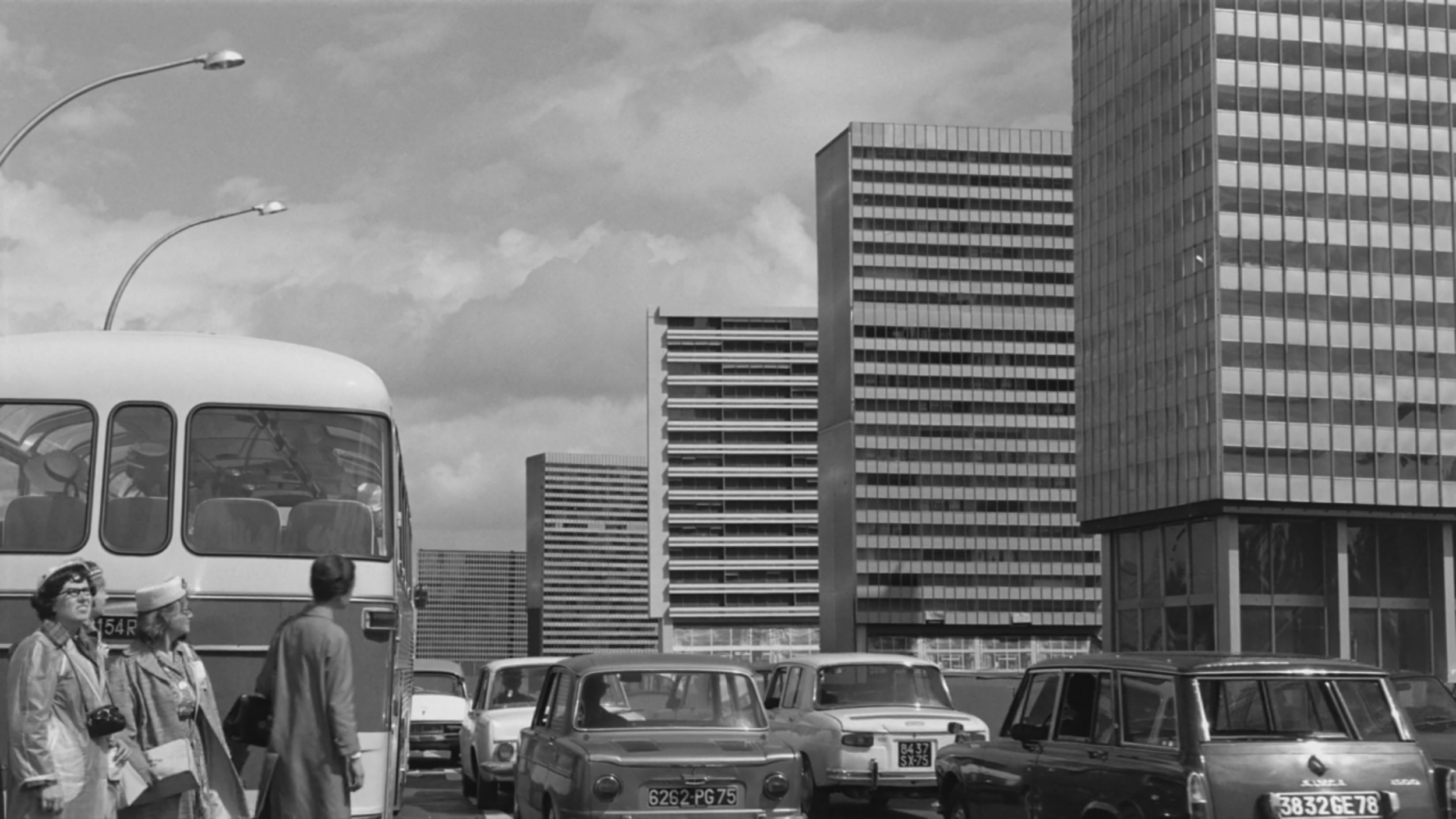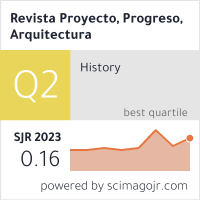El EL IMAGINARIO FÍLMICO SUBURBIAL DE LOS AÑOS SESENTA. EL FIN DE LAS UTOPÍAS MODERNAS
DOI :
https://doi.org/10.12795/ppa.2022.i27.01Mots-clés :
arquitectura y cine, ciudad satélite, megaestructuras, imaginario urbano, suburbioRésumé
A partir de la segunda guerra mundial las ciudades experimentaron un acusado incremento de población, debiendo expandir sus límites y reconfigurando la relación centro-periferia. Aparecieron conjuntos suburbanos que, bajo los preceptos de la ciencia y las promesas del progreso, auspiciaban con gran optimismo un nuevo futuro. A mediados de los años sesenta la realidad era bien distinta. Estas actuaciones mostraron grandes niveles de conflictividad, situación que fue reflejada en la producción cinematográfica. El artículo indaga sobre la introducción de una crítica urbana en cierta filmografía de ese período a través de tres películas representativas de esta manera de relatar tanto los nuevos conjuntos suburbiales como las megaestructuras. En Dos o tres cosas que yo sé de ella (Godard, 1967), La naranja mecánica (Kubrick, 1971) o Vinieron de dentro de… (Cronenberg, 1975) las propuestas urbanas van a tener un protagonismo radical, relatándose los espacios del suburbio como los espacios de la soledad o de la violencia. Todas ellas contribuyeron en gran medida a la conformación de un imaginario urbano negativo que se iba a extender sobre el movimiento moderno, poniendo fin a las utopías que se habían formulado sobre la ciudad del futuro.
Téléchargements
Références
AUGÉ, Marc. Los no lugares. Espacios del anonimato. Barcelona: Gedisa, 2008. ISBN 9788474324594.
BANHAM, Reyner. Megaestructuras. Futuro urbano del pasado reciente. Barcelona: Gustavo Gili, 2001 [orig. 1976]. ISBN 9788425218514.
CARDIN, Aurélie. Les 4000 logements de La Courneuve: réalités et imaginaires cinématographiques. En: Cahiers d’histoire critique. Revue d'histoire critique. Le logement social en région parisienne au XXe siècle. Paris, 2006, n.º 98, pp. 65-80. ISNN 2102-5916. DOI: https://doi.org/10.4000/chrhc.864.
CIMENT, Michel. Kubrick. Madrid: Akal, 2000.
GARCÍA GÓMEZ, Francisco. ¿Futuro imperfecto? Distopía y arquitectura moderna en La Naranja Mecánica de Stanley Kubrick. En: Anales de Historia del Arte. Madrid: Universidad Complutense, 2015, vol. 25, 2015, pp. 255-281. ISSN: 0214-6452. DOI: https://doi.org/10.5209/rev_ANHA.2015.v25.50858.
GARCÍA VÁZQUEZ, Carlos. Teorías e historia de la ciudad contemporánea. Barcelona: Gustavo Gili, 2016. ISBN 9788425228742.
GIEDION, Sigfried. Espacio, tiempo y arquitectura. Madrid: Dossat, 1982 [orig. 1941]. ISBN 9788429121179.
GUBERN, Roman. Godard polémico. Barcelona: Tusquets, 1974. ISBN 9788472235045.
HALL, Peter. Ciudades del mañana. Historia del urbanismo del siglo XX. Barcelona: Ediciones del Serbal, 1996. ISBN 9788476281901.
JACKSON MARTÍN, Rafael. Futuro en pretérito. Apropiaciones visuales del pasado en la ciencia ficción distópica. En: Secuencias. Revista Revista de historia del cine. Madrid: Universidad Autónoma de Madrid, 2013, n.º 38, 2013, pp. 15-46. ISNN 1134-6795. Disponible en: https://revistas.uam.es/secuencias/article/view/5862/6313.
JENCKS, Charles. El lenguaje de la arquitectura posmoderna. Barcelona: Gustavo Gili, 1980 [orig. 1977].
KUHN, Annette. Reflections. En: Alien Zone. Cultural Theory and Contemporary Science Fiction Cinema. London-New York: Verso, 1990. ISBN 9780860919933.
LEFEBVRE, Henri. El derecho a la ciudad. Barcelona: Península, 1978.
LIPPOLIS, Leonardo. Viaje al fin de la ciudad. La metrópolis y las artes en el otoño posmoderno. Madrid: Enclave, 2015. ISBN 9788494270840.
MALLGRAVE, Harry Francis; GOODMAN, David. An Introduction to Architectural Design. 1968 to the Present. Oxford: Wiley-Blackwell, 2011. ISBN 978-1-405-18062-7.
MARZAL FELICI, José Javier; RUBIO MARCO, Salvador. Guía para ver La naranja mecánica (Stanley Kubrick, 1971). Valencia-Barcelona: Nau LLibres-Octaedro, 1999.
MAURER, Jacqueline. Questions d’échelle et de justesse entre cinéma, architecture et urbanisme, Deux ou trois choses que je sais d’elle (1967) de Jean-Luc Godard et le débat des grands ensembles. En: Images seconds [en línea]. Paris: Association Images secondes, 2020, n.º 2 [consulta: 14-01-2022]. ISSN: 2649-3381. DOI: https://doi.org/10.5167/uzh-182042.
MAURER, Jaqueline. Cadre de vie. Jean-Luc Godard’s Deux ou trois choses que je sais d’elle (1967), French TV and Architectural Discourse. En: Kwartalnik Filmowy. Polska Akademia Nauk, 2020, n.º 109, pp. 68-85. DOI: https://doi.org/10.5167/uzh-199818.
McDOUGAL, Stuart Y., ed. Stanley Kubrick’s A Clockwork Orange. Minnesota: Cambridge University Press, 2003. ISBN 9780521574884.
MONTANER, Josep María. Escena postmoderna y arquitecturas paradójicas. En: El Croquis. Madrid: El Croquis Editorial. 1985, n.º 19, pp. 4-10.
MUMFORD, Lewis. La ciudad en la historia. Logroño: Pepitas de calabaza, 2012 [orig. 1961].
OCKMAN, Joan. Architecture in a Mode of Distraction: Eight Takes on Jacques Tati’s Playtime. En: Mark LAMSTER, ed. Architecture and Film. New York: Princenton Architectural Press, 2000.
PORTOGHESI, Paolo. Después de la arquitectura moderna. Barcelona: Gustavo Gili, 1981. ISBN 8425210798.
RIESMAN, David. La muchedumbre solitaria. Barcelona: Paidós, 1981. ISBN 9788475091198.
RIVERA, David. “Paraísos melancólicos. La utopía de los conjuntos megaestructurales”. En Teatro Marittimo: Revista de cine+arquitectura. Madrid: Fundación Diego de Sagredo, septiembre 2011, n.º 1, pp. 67-99. ISSN: 2174-6435.
RIVERA, David. Tabula Rasa. El movimiento moderno y la ciudad maquinista en el cine (1960-2000). Madrid: Fundación Diego de Sagredo, 2005. ISBN 84-933985-2-7.
SAMBRICIO, Carlos. “De Metrópolis a Blade Runner: dos imágenes urbanas de futuro”. En Revista de Occidente, nº185, octubre 1996, pp. 45-63. ISSN: 0034-8635. Disponible en: https://oa.upm.es/1554/1/SAMBRICIO_ART_1996_02.pdf.
SAN NICOLÁS JUÁREZ, Helia de. Documentando Tativille: La ciudad moderna según Jacques Tati. En: Teatro maríttimo. La identidad de la ciudad. Madrid: Fundación Diego de Sagredo, junio 2016, n.º 5, pp. 102-113.. ISSN: 2174-6435.
SONTAG, Susan. Godard. En: Estilos radicales. Barcelona: Muchnik, 1985. ISBN 9788483464984.
SORLIN, Pierre. Cines europeos, sociedades europeas. Barcelona: Paidós, 1996 [orig. 1991]. ISBN 9788449302251.
TAUBIN, Amy. 2 or 3 Things I Know Abotu Her: The Whole and Its Parts. En: The Criterion Collection. Essays [en línea]. Criterion Channel, 21 de julio de 2009 [consulta: 22-07-2021]. Disponible en: https://www.criterion.com/current/posts/1198-2-or-3-things-i-know-about-her-the-whole-and-its-parts.
UZAL, Marcos. Las paradojas de la Nouvelle Vague. En: Cinema Comparat/ive Cinema. Barcelona: Universitat Pompeu Fabra, 2013, vol. 1, n.º 2, pp. 81-86. ISSN: 2014-8933.
VALLE CORPAS, Irene. “Memento Vivere” o como escapar de “Alphaville”. Algunas notas sobre Godard y el situacionismo. En: Escritura e imagen. Madrid: Universidad Complutense, diciembre 2018, n.º 14, pp. 9-27. ISSN: 1885-5687. DOI: https://doi.org/10.5209/ESIM.62758.
VINCE, Owen. Anxius Metropolis: Alienation and the Cinema of 1960s Paris in Alphaville and Playtime. En Senses of Cinema[en línea]. Melbourne, julio 2016, vol. 79 [consulta: 02-02-2022]. Disponible en: https://www.sensesofcinema.com/2016/feature-articles/alienation-alphaville-playtime/

Téléchargements
Publié-e
Comment citer
Numéro
Rubrique
Licence
Las ediciones impresa y electrónica de esta Revista son editadas por el Secretariado de Publicaciones de la Universidad de Sevilla, siendo necesario citar la procedencia en cualquier reproducción parcial o total.
Salvo indicación contraria, todos los contenidos de la edición electrónica se distribuyen bajo una licencia de uso y distribución “Creative Commons Atribución-NoComercial-SinDerivar 4.0 Internacional” ![]() . Puede consultar desde aquí la versión informativa y el texto legal de la licencia. Esta circunstancia ha de hacerse constar expresamente de esta forma cuando sea necesario.
. Puede consultar desde aquí la versión informativa y el texto legal de la licencia. Esta circunstancia ha de hacerse constar expresamente de esta forma cuando sea necesario.
Los autores/as que publiquen en esta revista aceptan las siguientes condiciones:
- Los autores/as conservan los derechos de autor y ceden a la revista el derecho de la primera publicación, con el trabajo registrado con la licencia de atribución de Creative Commons, que permite a terceros utilizar lo publicado siempre que mencionen la autoría del trabajo y a la primera publicación en esta revista.
- Los autores/as pueden realizar otros acuerdos contractuales independientes y adicionales para la distribución no exclusiva de la versión del artículo publicado en esta revista (p. ej., incluirlo en un repositorio institucional o publicarlo en un libro) siempre que indiquen claramente que el trabajo se publicó por primera vez en esta revista.
- Se permite y recomienda a los autores/as a publicar su trabajo en Internet (por ejemplo en páginas institucionales o personales) antes y durante el proceso de revisión y publicación, ya que puede conducir a intercambios productivos y a una mayor y más rápida difusión del trabajo publicado (vea The Effect of Open Access).








